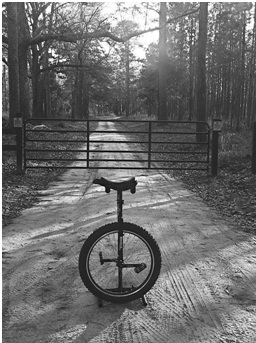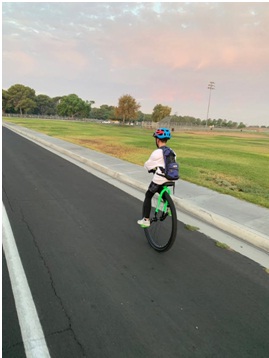A Vindication of 32 Inch Tires
11/23/20
Whether you are a seasoned one-wheel rider or are a first-timer looking for more information on the sport, you’re in the right place to find some gems of wisdom and insight. We have many years of experience with all things related to unicycles and unicycle riding, and our blog is your number one source to find them.
Among the various things that differ slightly (or substantially, depending on how you see it) between the many models of unicycles that you’ll come across is tire size. Like frame material, saddle size and high, styles of crankset and tire width, tire size can and will impact your comfort and your abilities when you take on a unicycle and start to ride.
Actually, tire size is one of the most important factors that will impact the performance and handling of a unicycle. For example, it’s one of the most important determining factors in the top speed that a unicycle can achieve, since the circumference of the tire is key to top speed.
However, it’s not just about speed. Let’s take a closer look at some other factors that tire size can affect in a unicycle.
Tire Size: Why It Matters
The greater the diameter of a unicycle’s tire, the greater the circumference will be. Therefore, a unicycle with a 32-inch tire will have a larger circumference than a 20-inch diameter tire. This means that for every single rotation of the wheel, the unicycle with the larger tire will cover more distance. This affects speed, as has been illustrated, but it is not the only factor that matters in this.
A term to understand in this is rotational momentum, which is a measure of the force that a wheel carries once it gets put into motion. It is also the force that is required simply to put the wheel in motion. To illustrate this, a wheel with a larger diameter will carry larger rotational momentum. This means that it will be easier to keep going at speed (assuming a smooth and even surface) but it also means that it takes more force, and thus more energy, to put it in motion in the first place.
Smaller tire diameters have less rotational momentum, which means that it requires more energy to keep the wheel turning and more energy to keep up a pace. However, this isn’t all bad news. Smaller tire sizes are also easier to stop and turn, and more agile than larger tire sizes. Some might say that for some purposes, unicycles with smaller tire sizes handle better than larger sizes. It really is a matter of the application. For example, freestyle riders might prefer a smaller tire size, and distance riders, commuters, or touring riders might prefer larger diameters.
In this article we’re going to go into some more detail on the matter of 32-inch tires for unicycles and where and why they can be useful, as they are often overlooked. First, let’s get some background on the other popular sizes of tires that you’ll find here on our site and elsewhere.
Smaller than 32 Inches
The majority of unicycles have tires that are smaller than 32 inches, and among the many options below, many are specialized to satisfy the specific needs of riders who follow different disciplines, like freestyle riders, muni riding, or trick riding.
1.12 Inch Unicycles - You’re not going to find many adults riding unicycles of this size. They’re just too small and too difficult to control for most adult riders. They’re not designed for adults anyway. The purpose of 12-inch unicycles is to serve as the first ride for a young child. They’re also not very forgiving because of their very limited size and need a smooth surface to ride on as the small tire size will magnify the effects of any impediments or uneven surfaces.
2.16 Inch Unicycles - Unicycles with 16-inch tires are more forgiving and adaptable than 12-inch unicycles, but they are also designed for children and younger riders. Also, though the tire is not quite as small as a 12-inch model, they are not suitable for riding on rough surfaces. It’s safer to ride them indoors, or only on smooth surfaces when outdoors.

3.20 Inch Unicycles - Unicycles that have 20-inch tires are suitable for learners of most ages, as long as they are sized appropriately (inseam length determines the proper size of a unicycle for a rider). The 20-inch tire size is relatively forgiving and more stable over uneven surfaces than 16-inch tires, although it still handles best on smooth terrain. Unicycles of this size are fairly agile and for that reason are popular for trick riders. However, because of the smaller tire size, they are not suitable for long-distance as they would require the expenditure of a large amount of energy.
4.24 Inch Unicycles - 24-inch tires give a unicycle better speed than 20-inch tires, and they are fairly versatile. They also make good unicycles for learners. Mountain riders and trick riders may use this tire size because it is useful for jumping, but some harder tricks can be difficult because of the larger tire size. Although it’s a good size to learn on, sizes above and below this tire size are probably more useful for specific disciplines like trick riding, mountain riding, or touring.
5.26 Inch Unicycles - Slightly larger than the 24-inch, the 26-inch tire can achieve slightly higher speeds and more rotational momentum than the 24-inch unicycle. It is in the middle of the road as far as size is concerned which makes it fairly versatile. Once you get into tire sizes beyond 24 inches, it becomes harder to hop and jump because smaller tires are easier to stop and control.
6.27.5 Inch Unicycles - This is one of the newest tire sizes available on the market, and some would say that it combines some of the strengths of a 24 and 26-inch unicycle into one.
7.29 Inch Unicycles - Once you get into unicycles with tire sizes of 29 inches, you’re working with greater rotational momentum, more distance covered per revolution of the tire, and a smoother ride. This makes unicycles with 29-inch tires better for commuting and distance riding, as riders will have to expand comparatively less energy due to the larger tire size
32 Inch Tires: Where They Shine
That brings us to the matter of 32-inch tires, which don’t get the spotlight very often. Unfortunately, some riders who are looking for a larger, easy tire for commuting or distance riding will glance right over the 32” tires in favor of 36-inch tires because they are bigger and more attractive.
In their minds, 36 inches are supreme - this is the largest size tire you’re going to come across, and they do enable a rider to generate the highest possible speeds when all other things are held constant. However, there’s more to this picture that deserves a second look.
Now, while it is fair to state that the 36 is supreme for speed, it doesn’t have that large of a margin over the 32-inch tire. When all other things are held even, the 36-inch tire will generate about 1 additional mile-per-hour over the 32-inch tire.
Compare this to the fact that the 32-inch model will be able to generate 2 to 3 miles-per-hour of the advantage of the next smallest model down, the 29-inch tire, and the 36-inch doesn’t seem as superior. Then, calculate the fact that the 32-inch model is more agile than a 36-inch model and it handles better as well, very similar to a 29-inch unicycle. It starts to seem like the advantage of a 36-inch unicycle over a 32 inch diminishes.
The 36-inch model has its place and can be a useful tool for commuters and long-distance riders. All we’re saying is that, although 32-inch models are somewhat less common, they deserve your consideration on this front. They handle very well, can be very comfortable to ride, and are hardly slower than a 36-inch unicycle.
That’s one of the reasons the 32-inch model deserves your evaluation, but of course, if you want more specific details or background information, contact us via our live chat or call us up at the number listed at the bottom of this article.
Larger than 32 Inches

Once you get beyond 32 inches, there’s really only one practical choice remaining, which is a 36-inch model. We’ve already covered some of the basic attributes and advantages of the 36-inch model above, but we’ll add a little here.
1.36 Inch Unicycles - In the minds of some commuters and long-distance riders, the 36-inch unicycle is the prime contender. It enables a rider to achieve the highest speeds and carries a lot of rotational momentum, which makes it great for those long-distance riders.
The catch comes with the fact the 36-inch tire is not as nimble as smaller tires are and are also harder to start, stop, and turn. This somewhat restricts the other of these larger tires to more specific applications. You’re not likely to see many trick riders in the saddle of a 36-inch unicycle.
That’s some insight into the different tire sizes that are commonly available in unicycles, but tire size is not the only thing that affects handling and performance. There are a few other comments we’d like to make on the matter.
A Note on Tire Width, Rim Construction, and Cranksets
●Tire Width - In addition to tire diameter, tire width is a huge impactor of the performance and handling of a unicycle. This is relatively easy to conceptualize. The thinner the tire is and the smoother the tread, the more easily it will ride over smooth pavement. The wider the tire is and the more aggressive the tread, the most smoothly it will ride over less forgiving and uneven ground. That is the reason that many unicycles designed for mountain riders have large tires with very aggressive tread patterns, and some unicycles designed for commuting and distance riding have thinner and smoother tires.
●Rim Construction - The construction of the rim will also affect the strength of the unicycle, and since some riders like to perform tricks or jumps that will place a lot of stress on the rims of their one-wheelers, it’s important to pick out a model that can handle such hard use. There are a ton of different rims for sale and it’s hard to tell at a glance which ones are useful for which disciplines, so call us for our input if you are unsure.
●Cranksets - As we covered in our recent blog, the cranksets can also impact the overall durability of the unicycle and how well it is able to handle rough terrain or tricks. As a general rule, splined or ISIS cranks are the highest quality types of cranks and get the most secure fitment to the axle, but that doesn’t mean square taper cranks aren’t useful in their way. Read our recent blog on crankset types and advantages to learn more.
Contact Us for More Information
If you still want to learn more about what affects how a unicycle will handle and how speed is affected, give us a call today at 678-494-4962. We’ll answer any questions you have and get you well on your way to your next - or your first - unicycle.
Otherwise, check out our blog where you can read up on interesting topics like the history of the Pennyfarthing, get a background on some of our odd bikes, or learn more about why riding a unicycle can help make you an all-around betterathlete. Also, check out our collection of odd bikes and unicycles that are arranged by discipline so you can get started on choosing a model that works for your intended purposes.
There’s plenty to learn, and where you come across any questions, call us at the number above!

